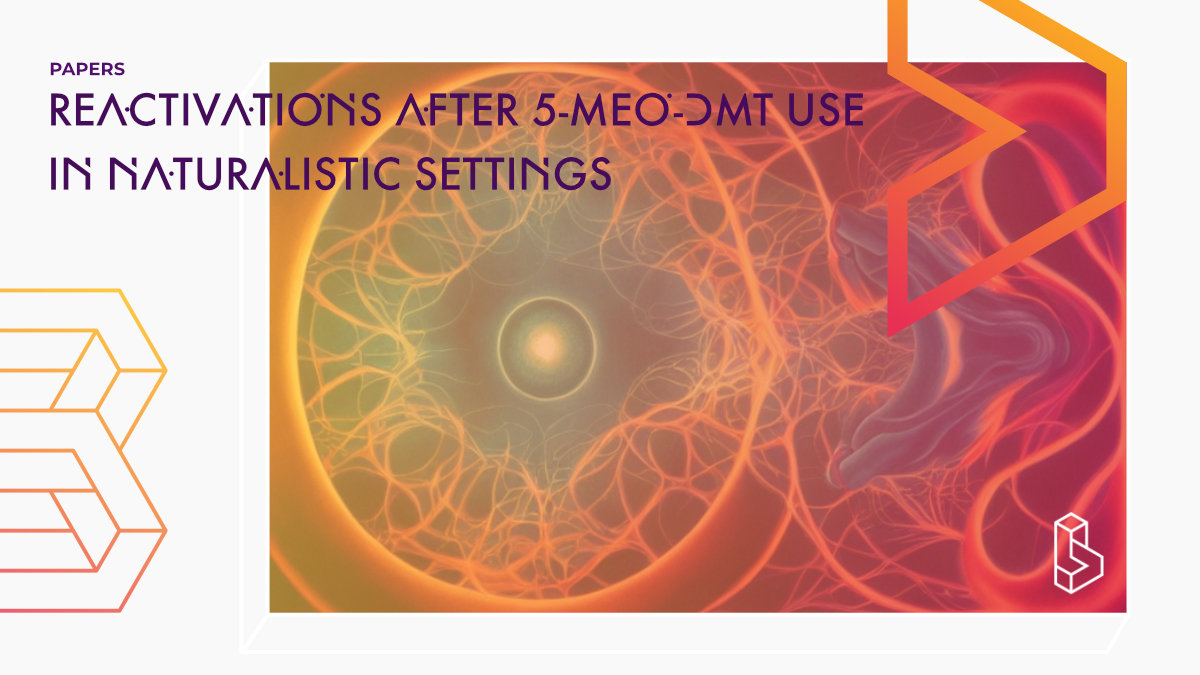This survey study (n=513) finds that reactivations (flashbacks) are common (27-86%) with 5-MeO-DMT use. The reactivations were generally perceived as positive (73-86%), with only some (4-7%) reporting them as negative. The change of reactivations was higher for those using 5-MeO-DMT in a structured setting, female, and older at the time of first use.
Abstract
“Background: The psychedelic 5-MeO-DMT has shown clinical potential due to its short duration and ability to induce mystical experiences. However, a phenomenon known as “reactivations” (similar to “flashbacks”) is a poorly understood and frequently reported phenomenon which appears associated with 5-MeO-DMT use and warranted further investigation.
Aims: This study examined whether differences in age, gender, education, lifetime use, use location, and preparation strategies predict reactivations (primary outcome). Additionally, we explored how reactivations were perceived by survey respondents and whether demographic data predicted emotional valence (secondary outcome) of reported reactivations.
Materials and methods: This study used secondary quantitative data from a survey assessing epidemiological and behavioral associations of 5-MeO-DMT use in non-clinical settings (N = 513). Descriptive statistics, chi-square tests, t-tests, and logistic regressions were utilized to explore aims.
Results: Being female, older at the time of first 5-MeO-DMT dose, having higher educational attainment, and dosing in a structured group setting were associated with increased odds of reporting a reactivation event. Higher mystical experience scores, greater personal wellbeing and having had a non-dual awareness experience that was not substance-induced were associated with higher likelihood of reporting a neutral or positive emotional valence of a reactivation event.
Conclusion: These findings suggest that reactivation phenomena, in this particular sample may most often represent a neutral or positive byproduct of the acute 5-MeO-DMT experience. More information is needed to best identify individuals most likely to experience a reactivation as a negative event to prevent such potential challenging outcomes.”
Authors: Ana M. Ortiz Bernal, Charles L. Raison, Rafael L. Lancelotta & Alan K. Davis
Summary of Reactivations after 5-MeO-DMT use in naturalistic settings
Recent years have seen renewed interest in using psychedelic substances to treat various psychiatric conditions. Psilocybin has been extensively studied, but its long-term effects may be prohibitive for underserved populations.
5-MeO-DMT is a short-acting psychedelic that has the potential to improve mental health disorders and improve well-being. It is found in numerous plants and in large quantities in the defence secretions of the Incilius alvarius toad, endemic to the Sonoran Desert.
Find this paper
https://doi.org/10.3389/fpsyt.2022.1049643
Open Access | Google Scholar | Backup | 🕊
Authors
Authors associated with this publication with profiles on Blossom
Charles RaisonCharles "Chuck" L. Raison is an American psychiatrist and professor of psychiatry. Next to his academic affiliation, he is also affiliated with the Usona Institute.
Rafaelle Lancelotta
Rafaelle Lancelotta, MS, LPC (they/she) is a white Latine (Cuban) transgender Nationally Certified Counselor and a PhD student at The Ohio State University College of Social Work researching the role of human relationship in psychedelic-assisted therapy.
Alan Davis
Alan Kooi Davis is an Assistant Professor of Social Work at The Ohio State University and Adjunct Assistant Professor in the Center for Psychedelic and Consciousness Research at Johns Hopkins University.
Institutes
Institutes associated with this publication
University of Wisconsin-MadisonThe Transdisciplinary Center for Research in Psychoactive Substances (TCRPS) was launched at the University of Wisconsin-Madison in 2021.
Linked Research Papers
Notable research papers that build on or are influenced by this paper
The epidemiology of 5-methoxy- N, N-dimethyltryptamine (5-MeO-DMT) use: Benefits, consequences, patterns of use, subjective effects, and reasons for consumptionThis first epidemiological survey study (n=515) found that 5-MeO-DMT was used infrequently (<1x p/y) and mostly for spiritual exploration.

